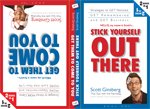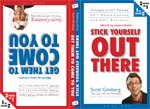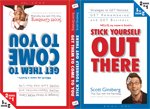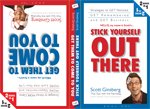 Everything on this planet has a life cycle.
Everything on this planet has a life cycle.
Products. Services. Industries. Plants. Planets. Animals. Ideas. Blogs. Relationships. Recessions. Religions. Philosophies.
Nothing is immortal.
Except for Keith Richards. Seriously, that guy just doesn’t die.
But when it comes to organizations, the same rule applies:
Non-profits. Faith communities. Charities. Clubs. Trade associations. Membership organizations. Volunteer groups. Outreach programs.
They have life cycles too. And whether or not you want to admit it – and whether or not it happens on your watch – closing down shop is inevitable. As often as you update, as frequently as you reinvent and as strategically as you promote, eventually, everything outlives its usefulness.
Everything has to die. And if your organization has degraded to the realm of uselessness, I triple dog dare you to consider the following strategies for shutting your doors:1. You can’t force feed involvement. People always make time for what’s important to them. Always. And sadly, it doesn’t matter how many phone calls you make, how amazing your meetings are or how inspiring the board of directors is.
Any number multiplied by zero is still zero. No matter how big that number is.
And if increasing your efforts won’t be enough to make a difference anyway – why kill yourself? Declining membership, poor volunteer support and lack of organizational vitality might have nothing to do with you.
It doesn’t mean people don’t like you – it just means they have different priorities. Or they’re tuned into different frequencies.
The ugly truth is: You might not fit into their lives anymore. And if your organization is struggling to become a regular part of your members’ schedule, that should tell you something.
If mediocrity is the highest you can get, you’re not being fair to yourself, your people or your organization. Are you throwing a life jack to something that’s already sunk to the bottom of the ocean?
2. Detachment mitigates the pain of quitting. As a leader of your membership-based organization, you’ve contributed your share. From dollars out of your own pocket to time away from your family to energy out of your own reserve, it’s not like you aren’t devoted to the success of the group.
And that’s exactly why it’s so hard to confront the mortality of your organization: Because you’ve already invested so much emotional labor. That’s the real issue: Not the shame of failure – but the emotional attachment to the thing that’s failing.
But, when you divorce your heart from of the problem, the solution becomes a no-brainer. That’s when you realize that just because something sucks – it doesn’t mean you suck.
And as a result, walking away doesn’t seem so bad anymore. Especially if you’re the only one putting in any effort. Or if three people are doing the work of ten. If that’s the case – or if that’s been the case for a while – maybe it’s time to stop fooling yourself.
Working overtime to convince yourself that this group going to work is a waste of your time and talents. This thing isn’t something to overcome – it’s something to outgrow. Are you preserving the illusion of something that’s not actually there just because you’d feel guilty if it wasn’t?
3. Celebrate your victories and walk off the field. In a recent article in FastCompany, non-profit thought leader Nancy Lublin writes, “Organizations don’t exist simply to exist. They should wear a termination notice as a badge of honor.”
What’s there to be ashamed of anyway? You had fun, did the best you could, learned a ton, helped the community, deepened relationships with key people and fulfilled your mission for as long as you could.
Don’t overstate the possibilities and exaggerate the potential of your organization out of guilt. The stress and frustration will slowly drive you insane.
If it’s not worth it anymore, if the efficacy of your efforts is outweighed by the frustration of the people who exert it – and if the point of diminishing returns has come and gone like a busboy in a burger joint – it’s time to throw in the towel.
Take whatever chips you’ve won, fold the hand and get on with your life.
People will be thrilled you read their minds, sacked up and made the call instead of them. Are you willing to confront your organizational expiration date?
4. When growing is no longer possible, give up. In Seth Godin’s book The Dip, I learned that people quit for two reasons: Either because it’s hard, or because it’s right. Let’s explore two examples:
If you shut your organizational doors because you don’t feel like getting up on Saturday mornings to attend meetings, you’re quitting because it’s hard.
But if you shut the doors because you regularly find yourself standing around when the music stops only to look up and notice that you’re the only one dancing while the rest of party either grabbed a chair or went home, you’re quitting because it’s right.
Ultimately, the decision to close shop is simply a matter of severity. It’s either a problem or a predicament. And your challenge is to discern the difference.
If it’s a problem, that means you can create a solution. Cool. But if it’s a predicament, all you can do is manage the response. Also cool.
Look: Every group runs its course. Don’t try to revive an organization that’s not important to people who aren’t even coming anyway. Dive into death. Are you using the shovel to make the hole bigger with one foot in the grave?
REMEMBER: There’s no shame in shutting your doors.
Especially if the hinges have been accumulating cobwebs for some time.
It’s never pleasant when you realize you’ve outlived your usefulness.
But it happens. Actually, it happens a lot.
And if that’s the case for your organization, my suggestion is simple:
Accept it, enjoy the ride and get on with your life.
Keith Richards would be proud.
LET ME ASK YA THIS…
Is it time for you to die?
LET ME SUGGEST THIS…
For the list called, “19 Telltale Signs of the Perfect Job,” send an email to me, and you win the list for free!
* * * *
Scott Ginsberg
That Guy with the Nametag
Author, Speaker, Entrepreneur, Mentor
[email protected]
 The world’s FIRST two-in-one, flip-flop book!
The world’s FIRST two-in-one, flip-flop book!
Buy Scott’s comprehensive marketing guidebook on Amazon.com and learn how to GET noticed, GET remembered and GET business!

 Rice paper amazes me.
Rice paper amazes me. The world’s FIRST two-in-one, flip-flop book!
The world’s FIRST two-in-one, flip-flop book! A few weeks ago we talked about
A few weeks ago we talked about  The world’s FIRST two-in-one, flip-flop book!
The world’s FIRST two-in-one, flip-flop book! I don’t edit.
I don’t edit. The world’s FIRST two-in-one, flip-flop book!
The world’s FIRST two-in-one, flip-flop book! The evidence is overwhelming:
The evidence is overwhelming: The world’s FIRST two-in-one, flip-flop book!
The world’s FIRST two-in-one, flip-flop book! Did you know that most “close door” buttons on elevators don’t work?
Did you know that most “close door” buttons on elevators don’t work? The world’s FIRST two-in-one, flip-flop book!
The world’s FIRST two-in-one, flip-flop book! You never know when your brand will need to rise to the occasion.
You never know when your brand will need to rise to the occasion.  The world’s FIRST two-in-one, flip-flop book!
The world’s FIRST two-in-one, flip-flop book! Know your customer.
Know your customer. The world’s FIRST two-in-one, flip-flop book!
The world’s FIRST two-in-one, flip-flop book!